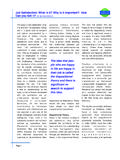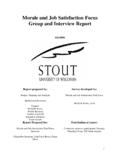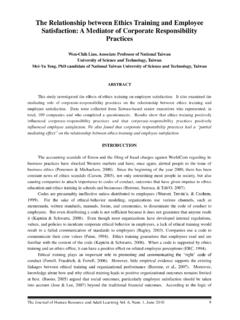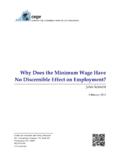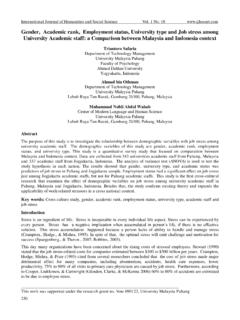Transcription of Measuring Satisfaction and Meaning at Work - …
1 Measuring Satisfaction and Meaning 1 Measuring Satisfaction and Meaning at Work Michael F. Steger1,2, Bryan J. Dik1, Yerin Shim1 1 Colorado State University, USA, 2 North-West University, South Africa Correspondence to: Michael F. Steger, Department of Psychology, Colorado State University, Fort Collins, CO, 80523-1876, Steger, M. F., Dik, B. J., & Shim, Y. (in press). Assessing Meaning and Satisfaction at work. In S. J. Lopez (Ed.), The Oxford handbook of positive psychology assessment (2nd Ed.). Oxford, UK. Oxford University Press. Measuring Satisfaction and Meaning at Work What makes work worth doing? Work provides a means of making a living, a way to occupy one s time, and a forum to satisfy achievement needs. However, from a positive psychological perspective, the answer to the question of why work is worthwhile goes far beyond these reasons. Instead, we should anticipate that the best work experiences add value to people s lives and are an important part of their personal and communitarian flourishing.
2 Ideally, work also is enjoyable, provides a desirable sense of challenge, and both cultivates and makes use of people s strengths. At its best, work also contributes to the health and equity of organizations, communities, and societies. There is a substantial volume of research on job Satisfaction , the most widely studied topic in organizational behavior research (Spector, 1997) and long a focal construct in both industrial-organizational and vocational psychology (Lent & Brown, 2006). Our PsychINFO search with the keyword job Satisfaction revealed nearly 3,500 articles since 2000, and high-quality measures of the constructs abound. Research on Meaning at work, on the other hand, is relatively new, and finding appropriate instruments to assess work Meaning can be challenging. In part, this is because research frequently has used proxy measures. In this chapter, our focus is on measures designed to assess job Satisfaction , meaningful work, and perceptions of work as a calling.
3 Whereas happiness has often served as a shorthand term and public face for positive psychology ( , Diener & Biswas-Diener, 2008; Gilbert, 2005; Lyubomirsky, 2006; Seligman, 2003), happiness per se has not made many in-roads into the world of work. In fact, we were unable to locate any measures of work happiness with even adequate psychometric support. Therefore, we begin with a review of job Satisfaction measures, which have provided a critical, although incomplete, contribution to our understanding of work-related well-being. We proceed to review measures of work Meaning and perceptions of work as a calling, two other constructs that overlap with work happiness. We close with observations and recommendations for future measurement of this aspect of positive human functioning. Measuring Job Satisfaction Job Satisfaction refers to how well people like their jobs, or more formally, an emotional state emerging from a cognitive appraisal of job experiences (Fritzsche & Parrish, 2005).
4 Most definitions of job Satisfaction focus on its affective component, although most measures of the construct place a greater emphasis on the cognitive aspects of the construct (Fisher, 2000). Job Satisfaction has been measured predominantly using self-report Measuring Satisfaction and Meaning 2 instruments that can be divided into two categories: (1) facet measures, which assess Satisfaction with specific aspects of a job such as job security, coworkers, working conditions, company policies, and opportunities for achievement, accomplishment, and advancement (Weiss, Dawis, England & Lofquist, 1967); and (2) global measures, which focus on overall appraisals of a job. As Fritzsche and Parrish (2005) note, no theory is available to guide selection of which facets are most important under which circumstances. Furthermore, global job Satisfaction does not equal the sum of the facet scores (Highhouse & Becker, 1993; Scarpello & Campbell, 1983).
5 Facet Measures The most popular facet measures of job Satisfaction are the Job Descriptive Index (JDI; Smith, Kendall, & Hulin, 1969), the Job Satisfaction Survey (JSS; Spector, 1985), and the Minnesota Satisfaction Questionnaire (MSQ; Weiss et al., 1967). The JDI is a 72-item scale in which respondents evaluate adjectives and phrases according to the extent to which each describes their job using the anchors yes, no, and uncertain (represented by ? ). Item responses are summed to provide scores on Satisfaction with Work, Pay, Promotions, Supervision, and Coworkers. Internal consistency reliabilities for JDI facets are in the .8s, and mean test-retest reliability coefficients averaged across multiple studies range from .56 to .67 across the facets. Meta-analytic evidence also supports the convergent and discriminant validity of JDI subscale scores, with facet scores correlating in predicted directions with criterion variables, conforming to a nomological net of job Satisfaction relations (Kinicki, Mckee-Ryan, Schriesheim, & Carson, 2002).
6 The shorter JSS uses 36 items with a 6-point scale ( strongly agree to strongly disagree ) to assess nine facets (Pay, Promotion, Supervision, Fringe Benefits, Contingent Rewards, Operating Procedures, Coworkers, Nature of Work, and Communication). Internal consistency reliabilities reported by Spector (1985) for the facets range from .60 (Coworkers) to .82 (Supervision), with a value of .91 for the total score and 18-month test-retest coefficients ranging from .37 to .71. A multitrait-multimethod matrix analysis using JSS and JDI facet scales supported their construct validity (Spector, 1985). Finally, the MSQ has 100-item and 20-item (5-point scale ranging from not satisfied to extremely satisfied ) versions that assess a total of 20 job Satisfaction facets, providing a comprehensiveness that many researchers find desirable. The scale scores have a median internal consistency reliability coefficients above .8, median one-week test-retest correlations of.
7 83, convergent and discriminant correlations that conform to hypotheses, and concurrent validity evidence from group differences in Satisfaction ( , Dawis, Pinto, Weitzel, & Nezzer, 1974; Dunham, Smith, & Blackburn, 1977; Weiss et al., 1967). Global Measures One frequently used measure of global job Satisfaction is the Job in General Scale (JIG; Ironson, Smith, Brannick, Gibson, & Paul, 1989), an 18-item scale designed for use in tandem with the JDI, serving as a more global, more evaluative, and longer in time frame (p. 195) measure. JIG items consist of adjectives or short phrases paired with the same response scale as the JDI. Internal consistency estimates range from .91 to .95, with convergent correlations of .66 to .80 with other global Satisfaction scales. Many researchers opt for very short measures of global job Satisfaction , particularly when job Satisfaction is a secondary focus in a study. For example, Chen and Spector (1991) used a 3-item scale that yielded an alpha of.
8 85 and correlated in predicted directions with convergent and discriminant criterion variables. Often even one-item scales are used ( , All and all, how satisfied would you say you are with your job? Quinn & Staines, 1979). One-item scales frequently are criticized, but Wanous, Reichers and Hudy (1997) demonstrated in a meta-analytic study that the corrected mean correlation between single-item and multi-item Measuring Satisfaction and Meaning 3 Satisfaction measures was r = .67, and the minimum estimated test-retest reliability for single items scales was r = .70. Summary Apart from the lack of theory available to guide selection of the facets in facet instruments, and the fact that scales emphasize cognitive rather than affective aspects of the construct, the measurement of job Satisfaction is a strength of research in organizational and vocational psychology. The most popular job Satisfaction instruments are well-designed and supported by strong evidence of reliability and validity.
9 Yet from a positive psychology perspective, questions can be raised regarding the comprehensiveness of construct. Job Satisfaction is a useful criterion for those interested in how favorably people view particular aspects of their jobs, or their jobs overall, but as typically assessed, job Satisfaction focuses mainly on hedonic well-being and, to a lesser extent, personal fulfillment. This overlaps with definitions of work Meaning and perceptions of work as a calling, but Meaning and calling emphasize eudaimonic aspects of well-being ( , a sense of purpose, contribution, and pro-social attitudes) that, if addressed by existing job Satisfaction scales at all, are usually a peripheral consideration. Measuring Meaningful Work Meaningful work can be considered an umbrella term, which subsumes a range of constructs, including work Meaning , work meaningfulness, and the positive connotations associated with the Meaning of work. Meaningful work refers broadly to the amount of significance people perceive to exist in their work (Rosso, Dekas, & Wrzesniewski, 2010).
10 Others have argued that, as in the broader psychological tradition of Meaning in life, work is meaningful not only when it is judged to be significant, but also when it is viewed as having a distinct purpose or point (Steger & Dik, 2009). A closely related term is calling. The idea of work serving as a calling has deep historical and religious roots. However, in modern parlance, a distinction has been made between neoclassical conceptualizations of calling that emphasize, duty, destiny, and a transcendent summons (Bunderson & Thompson, 2009; Dik & Duffy, 2009), and modern conceptualizations that frame calling as an inner drive to do fulfilling and self-actualizing work (Baumeister, 1991; Hall & Chandler, 2005). We will review scholarly definitions of calling in a later section. First, we will examine the ways in which meaningful work has been defined and operationalized. Two trends have dominated meaningful work assessment. The first is the guiding influence of an early definition of meaningful work.




